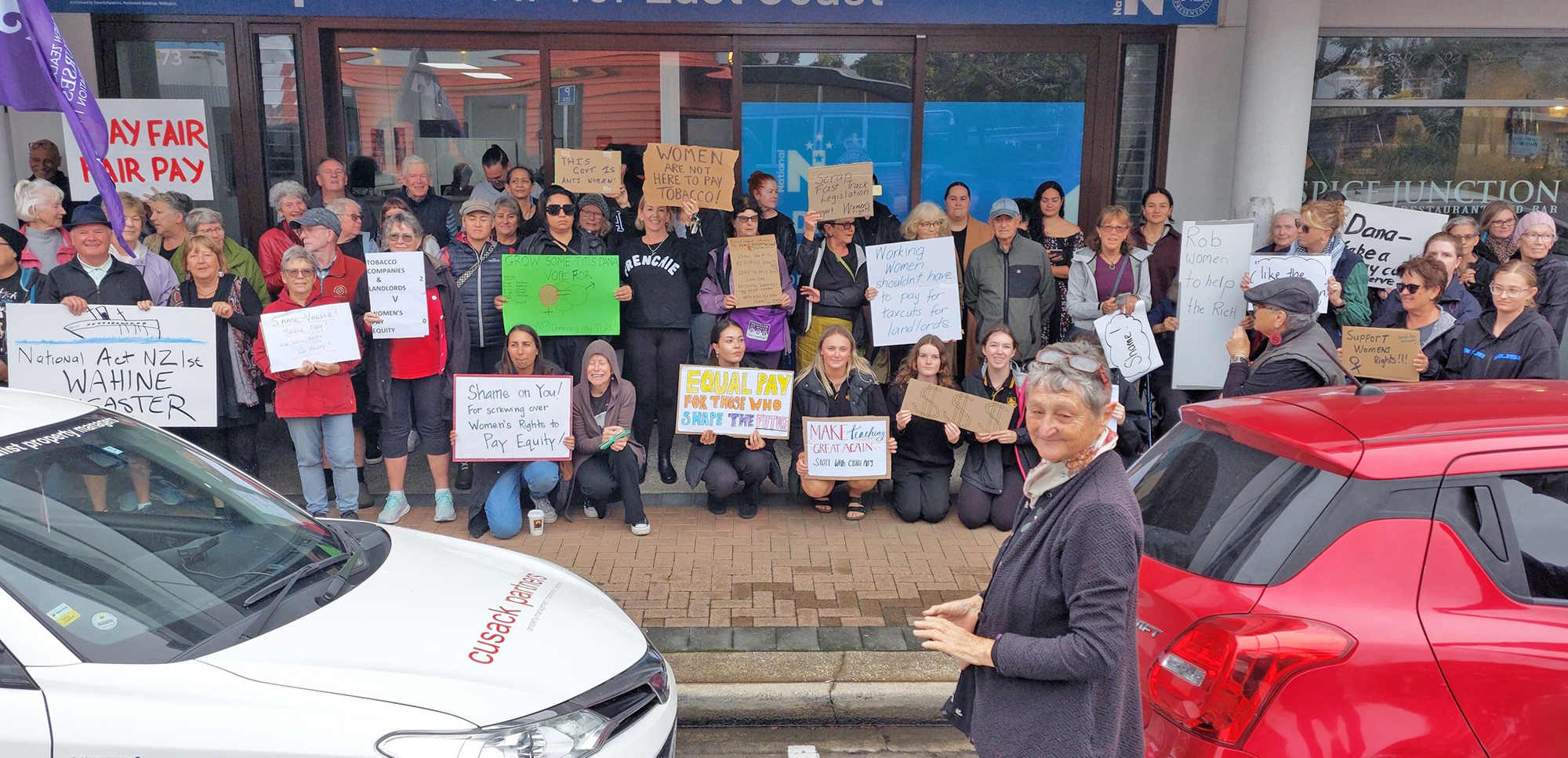Back to square one for pay equity - protesters

Fair pay: Social justice advocate Ruth Gerzon was among the dozens of protesters outside East Coast MP Dana Kirkpatrick’s office in Whakatāne on Friday. Photo supplied
Diane McCarthy
Whakatāne support workers, teachers, health care workers and those who support them in their battle for pay equity took part in a nationwide protest on Friday in response to the Government’s controversial pay equity law change.
More than 80 people stood outside East Coast MP Dana Kirkpatrick’s office on Strand East with placards protesting the Pay Equity Amendment Bill that passed on Wednesday after being rushed through Parliament under urgency.
The law change raises the threshold for proving work in industries dominated by women has been historically undervalued when making a pay equity claim.
The legislation means 33 equity claims representing thousands of workers will now have to restart the process under new criteria.
The Government said the changes were necessary to make the law more fair. It has also said the new law would significantly reduce costs for the Crown.
One of the organisers for the Whakatāne protest, Danae Lee, said she knew of many Whakatāne people whose claims had been effectively wiped out by the bill being passed.
“Schoolteachers, nurses, careworkers ... all the people that were affected by it, they just have to go back to square one. It’s pretty upsetting.”
She said as well as holding placards, a lot of people stood up and shared their stories on Friday.
“It was quite impactful. We had a couple of young wahine from the high school stood up and spoke to it, and people like support services, teachers, health care workers.
“On a personal level, it was pretty upsetting to see some of my closest friends and whānau who are members of those professions having to wait longer when a lot of them have already been waiting for five or more years.”
She said rather than saving money, making people renew their claims would cost a lot more.
“It seems like a false economy to me.”
She said the number of people out protesting nationally showed the rushed process had been a poor decision.
“For it to be unrolled at such a rapid rate with no democratic guardrails is part of the reason [for the protests]. If they were going to do it, maybe put it out for consultation.”
Ms Kirkpatrick said the Government was not stopping the fight for pay equity and workers would still be able to raise and settle equity claims.
“We absolutely support that, we support women, and we believe in equal pay.”
She said the law introduced in 2020 had resulted in many cases where gender-based undervaluation was not the core focus.
“Other factors in the labour market were being brought into the equation and sometimes the Act had been used as a collective bargaining tool.
“When you have a system that compares nurses to fishery offices, admin staff to engineers, it’s clear that the system has flaws.”

'We are not ditching pay equity' - East Coast MP
Dana Kirkpatrick, East Coast MP
FIRSTLY, let’s talk about the facts, we are not cutting pay, we are not ditching pay equity, and we also support equal pay.
Under the pay equity changes, no woman has had her pay cut. The 12 pay equity settlements reached to date including for nurses, social workers, midwives, teacher aides, school librarians, care and support workers remain.
Those settlements resulted in higher pay for tens of thousands of women, and they continue to be funded by the Government, at a cost of around $1.8 billion a year. The pay of these women is not at risk.
Claims are still able to be raised under the new system and further pay equity settlements are expected. The Government has set aside a large amount of money to fund these claims under the new law.
So why has the Government made changes to pay equity?
The first pay-equity claim was proved in the Supreme Court by Kristine Bartlett on behalf of thousands of care and support workers.
In response, the last National Government delivered the first pay-equity settlement in New Zealand. It then designed a clear legal regime so other claims could be progressed without workers having to resort to the courts. However, in 2020 the Labour Government put its own pay equity regime in place. This saw administration workers compared with civil engineers; social workers compared with detectives; and librarians compared with fishery officers.
What started under National as a clear pay equity regime to redress historically underpaid female-dominated workforces, became a multi-billion-dollar grievance industry that departed a very long way from issues of sex-discrimination. It also became completely unaffordable.
The Government has now put in place a more workable pay equity regime. It has set out a transparent process through which employers and employees can negotiate the question of equal value. These changes enable the Government to unwind a forecast blow-out in pay equity costs while ensuring New Zealand retains an affordable fair pay equity scheme focused on genuine sex-based discrimination.
They also mean a lot more money can now be invested in other services Kiwis need, like schools, hospitals, roads and other much needed initiatives.